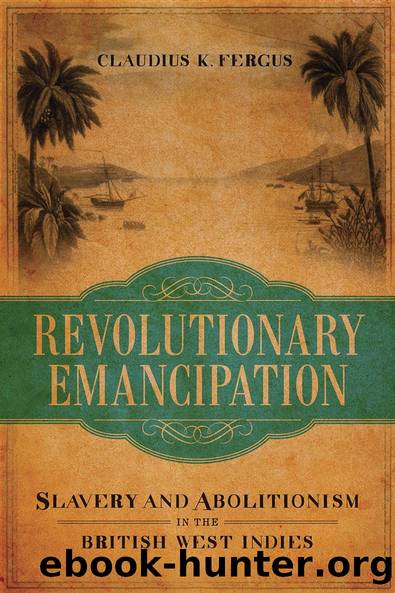Revolutionary Emancipation by Claudius K. Fergus

Author:Claudius K. Fergus [Fergus, Claudius K.]
Language: eng
Format: epub
Tags: History, United States, State & Local, South (AL; AR; FL; GA; KY; LA; MS; NC; SC; TN; VA; WV), Caribbean & West Indies, General, Social Science, Slavery
ISBN: 9780807149898
Google: kUrRM-RVRJ4C
Publisher: LSU Press
Published: 2013-06-10T05:40:38+00:00
9
THE LAUNCH OF IMPERIAL AMELIORATION
The Balance of Amelioration to 1823
Postconquest economic policy in Trinidad frustrated the limited objectives of amelioration. The lure of Trinidadâs virgin soils and high sugar prices presented major challenges to the imperial governmentâs policy of curbing the plantation revolution. Despite the largely successful land policy, sugar estates increased from 192 to 221 between 1802 and 1813.1 Although the average plantation labor force was greatly enlarged under English ownership, the phenomenal increase in sugar production from 1805 was disproportionate to the growth of the labor force. Sugar exports rose from 4.9 million pounds in 1799 to 15 million pounds within ten years; with only a slight increase in the official labor force, exports rose to 18.5 million pounds by 1813. At 1833 this figure had doubled to 37.7 million pounds, despite an officially declining labor force. Estate expansion also continued apace, with total acreage under cane doubling between 1808 and 1832.2 Cocoa, the second biggest money earner, also rapidly expanded production until 1827, when prices declined dramatically and precipitated the abandonment of many estates.3 The rapid expansion of the economy, the falling wartime prices for sugar, the maintenance of high wartime duties, and the large investments in steam technology all combined to sustain old attitudes of extracting the maximum labor in the shortest possible time.4 The short-term profit outlook made estate management more oppressive as ownership changed hands from French and Spanish proprietors to English mortgage houses. Increasingly, it was not the planters who called the shots but the mortgagees, as in the old colonies.5 As William Burnley lamented, the Trinidad planter was increasingly becoming only âthe Tenant of an English mortgagee, and the foreman of his manufactory.â 6 Abolitionists also recognized this development as a major problem for amelioration.7
Increased cultivation in Trinidad did not impact the average number of laborers per estate, thus denying the island the demographics of a true plantation colony. In Trinidad the small gang was common to all types of plantation staples. At the turn of the century Mayaro (on the southeast coast) was âvirtually covered with sugar plantations,â although the 120 settlers and 380 laborers there were more akin to peasant than plantation demography; Guayaguayare, in the distant southeastern corner of the colony, with 66 planters and 400 laborers, was equally removed from true plantation status.8 By 1813 there were 205 estates in the colony with 1 to 5 laborers; 103 estates with 6 to 10 laborers; 234 estates with 11 to 50 laborers; 83 estates with 51 to 100 laborers; and a mere 26 estates with more than 100 laborers. Of the 109 estates with more than 50 laborers, 96 were pure sugarcane plantations, 3 grew cane and coffee, and 1 cane and cocoa. On the other hand, of the 542 estates with 1 to 50 laborers, 125, or 23 percent, were cane.9 Many small farmers occupied lands granted after 1802 under a proviso to grow food crops rather than export staples. The phenomenon of estates with less than 10 laborers was compounded by the large size of âdomestics,â a subgroup of âpersonal slaves.
Download
This site does not store any files on its server. We only index and link to content provided by other sites. Please contact the content providers to delete copyright contents if any and email us, we'll remove relevant links or contents immediately.
| United States | Abolition |
| Campaigns & Battlefields | Confederacy |
| Naval Operations | Regimental Histories |
| Women |
In Cold Blood by Truman Capote(2702)
Steve Jobs by Walter Isaacson(2459)
All the President's Men by Carl Bernstein & Bob Woodward(1971)
Lonely Planet New York City by Lonely Planet(1857)
The Murder of Marilyn Monroe by Jay Margolis(1751)
The Room Where It Happened by John Bolton;(1729)
The Poisoner's Handbook by Deborah Blum(1671)
And the Band Played On by Randy Shilts(1632)
Lincoln by David Herbert Donald(1622)
The Innovators by Walter Isaacson(1612)
A Colony in a Nation by Chris Hayes(1530)
The Innovators: How a Group of Hackers, Geniuses, and Geeks Created the Digital Revolution by Walter Isaacson(1519)
Under the Banner of Heaven: A Story of Violent Faith by Jon Krakauer(1425)
The Unsettlers by Mark Sundeen(1347)
Amelia Earhart by Doris L. Rich(1345)
Birdmen by Lawrence Goldstone(1345)
Decision Points by George W. Bush(1261)
Dirt by Bill Buford(1247)
Zeitoun by Dave Eggers(1231)
